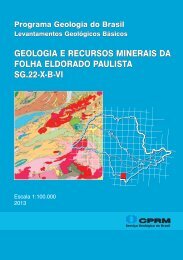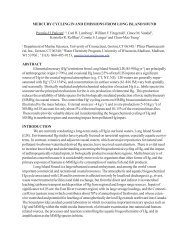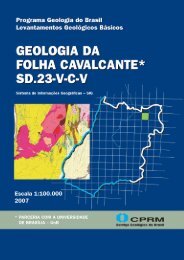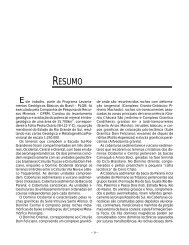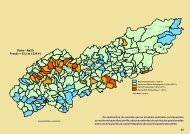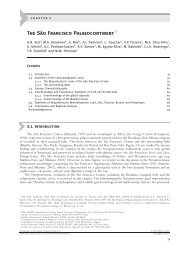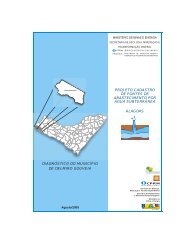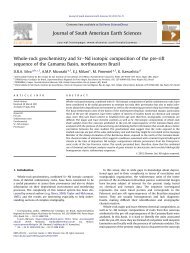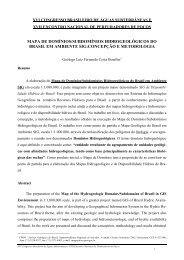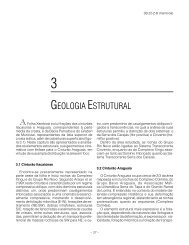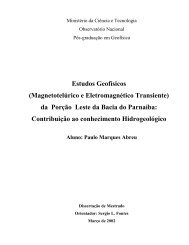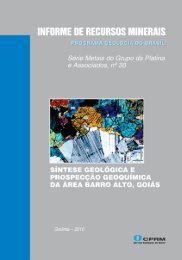Origin of the CO2-only fluid inclusions in the ... - CPRM
Origin of the CO2-only fluid inclusions in the ... - CPRM
Origin of the CO2-only fluid inclusions in the ... - CPRM
Create successful ePaper yourself
Turn your PDF publications into a flip-book with our unique Google optimized e-Paper software.
However, <strong>the</strong> distribution <strong>of</strong> values varies among dist<strong>in</strong>ct samples<br />
(Fig. 6B). In <strong>the</strong> high-grade quartz <strong>only</strong> temperatures below 12.9 °C<br />
have been recorded (correspond<strong>in</strong>g to high <strong>CO2</strong> densities <strong>of</strong> 1.070 to<br />
0.893 g/cm 3 ), and <strong>in</strong>ternal variations <strong>in</strong> a s<strong>in</strong>gle cluster or trail <strong>of</strong> this ve<strong>in</strong><br />
are mostly <strong>of</strong> 2 to 7 °C, although variations can reach as much as 30 °C.<br />
Fur<strong>the</strong>rmore, all moderate to strongly negative temperatures have been<br />
recorded <strong>only</strong> <strong>in</strong> this type <strong>of</strong> quartz and <strong>the</strong> shape <strong>of</strong> <strong>the</strong> histogram is<br />
strongly skewed to <strong>the</strong> right.<br />
In <strong>the</strong> low-grade quartz Th<strong>CO2</strong> varied between 0 and 18 °C (<strong>CO2</strong><br />
densities <strong>of</strong> 0.928 to 0.795 g/cm 3 ), with <strong>the</strong> histogram show<strong>in</strong>g a poorly<br />
def<strong>in</strong>ed peak at 9 °C (Fig. 6B). In <strong>the</strong> late quartz ve<strong>in</strong>lets, <strong>the</strong><br />
homogenisation ranges from −0.3 to 29.9 °C (densities <strong>of</strong> 0.930 to<br />
0.600 g/cm 3 ), and <strong>the</strong> values are discont<strong>in</strong>uously distributed (Fig. 6B).<br />
Formation <strong>of</strong> clathrates was not observed <strong>in</strong> Type 1 <strong><strong>in</strong>clusions</strong>, which<br />
was expected given <strong>the</strong> absence <strong>of</strong> visible water <strong>in</strong> <strong>the</strong> <strong><strong>in</strong>clusions</strong>.<br />
Surpris<strong>in</strong>gly, however, H2O that was not identified <strong>in</strong> <strong>the</strong> petrographic<br />
and micro<strong>the</strong>rmometric studies was detected by <strong>the</strong> Raman analysis <strong>in</strong><br />
some <strong><strong>in</strong>clusions</strong>. This compound is, thus, subord<strong>in</strong>ate (b10 vol.%) and<br />
likely occurs as t<strong>in</strong>y “<strong>in</strong>visible” rims <strong>in</strong>volv<strong>in</strong>g <strong>the</strong> CO 2 bubble (e.g.,<br />
Hedenquist and Henley, 1985).<br />
In <strong>the</strong> seven Type 2 aqueous-carbonic <strong>fluid</strong> <strong><strong>in</strong>clusions</strong> from <strong>the</strong> late<br />
quartz ve<strong>in</strong>let, Tm<strong>CO2</strong> values were recorded mostly at −57.7 °C, but also<br />
at −56.6 °C. The T hCO 2 took place to liquid between 23.5 and 26.5 °C<br />
(densities <strong>of</strong> 0.70–0.73 g/cm 3 ), and clathrates melted between 7.2 and<br />
7.6 °C, <strong>in</strong>dicat<strong>in</strong>g sal<strong>in</strong>ities around 5.0 to 5.4 wt.% NaCl equiv.. The f<strong>in</strong>al<br />
homogenisation, also to liquid, occurred <strong>in</strong> <strong>the</strong> range <strong>of</strong> 264 to 346 °C.<br />
7. Discussion<br />
7.1. <strong>Orig<strong>in</strong></strong> <strong>of</strong> <strong>the</strong> one-phase carbonic <strong>fluid</strong> <strong><strong>in</strong>clusions</strong><br />
The peculiar absence <strong>of</strong> significant H2O contents <strong>in</strong> <strong>the</strong> <strong>fluid</strong> <strong><strong>in</strong>clusions</strong><br />
contrasts with <strong>the</strong> hydrous m<strong>in</strong>eralogy (muscovite+tourmal<strong>in</strong>e) occurr<strong>in</strong>g<br />
<strong>in</strong> close association with <strong>the</strong> gold–quartz ve<strong>in</strong>. This might be product<br />
<strong>of</strong>: (1) preferential leakage <strong>of</strong> H 2O from <strong>the</strong> <strong><strong>in</strong>clusions</strong>; (2) unmix<strong>in</strong>g <strong>of</strong> a<br />
H2O–<strong>CO2</strong> <strong>fluid</strong> followed by preferential trapp<strong>in</strong>g <strong>of</strong> <strong>CO2</strong>; and/or (3) two<br />
<strong>fluid</strong>s (CO 2-rich and H 2O-rich) operat<strong>in</strong>g separately.<br />
Water leakage leads to a decrease <strong>in</strong> <strong>the</strong> density <strong>of</strong> <strong>the</strong> rema<strong>in</strong><strong>in</strong>g<br />
<strong>fluid</strong> (Crawford and Hollister, 1986; Huizenga and Touret, 1999; Kle<strong>in</strong><br />
et al., 2006). However, <strong>the</strong> <strong><strong>in</strong>clusions</strong> <strong>in</strong> <strong>the</strong> high-grade quartz show<br />
<strong>the</strong> highest density values. Fur<strong>the</strong>rmore, o<strong>the</strong>r textural evidence <strong>of</strong><br />
leakage, such as t<strong>in</strong>y trails <strong>of</strong> aqueous <strong><strong>in</strong>clusions</strong> depart<strong>in</strong>g from <strong>the</strong><br />
larger carbonic <strong><strong>in</strong>clusions</strong>, is also lack<strong>in</strong>g. Moreover, Th<strong>CO2</strong> variations<br />
<strong>in</strong> micro-doma<strong>in</strong>s <strong>of</strong> <strong>the</strong> host quartz are <strong>in</strong> general limited. So, it is<br />
unlikely that <strong>the</strong>ir water content has significantly leaked, and <strong>the</strong><br />
E.L. Kle<strong>in</strong>, K. Fuzikawa / Ore Geology Reviews 37 (2010) 31–40<br />
Fig. 6. Frequency histograms show<strong>in</strong>g <strong>the</strong> micro<strong>the</strong>rmometric properties <strong>of</strong> <strong>fluid</strong> <strong><strong>in</strong>clusions</strong> from <strong>the</strong> Carará gold deposit. (A) Melt<strong>in</strong>g temperature <strong>of</strong> <strong>the</strong> carbonic phase (Tm<strong>CO2</strong>).<br />
(B) Homogenisation temperature <strong>of</strong> <strong>the</strong> carbonic phase (T hCO 2) for <strong>in</strong>dividual types <strong>of</strong> quartz ve<strong>in</strong>s. LGQ (low-grade quartz), HGQ (high-grade quartz), QTV (late barren quartz<br />
quartz-tourmal<strong>in</strong>e ve<strong>in</strong>let).<br />
dense <strong>CO2</strong>-rich <strong>fluid</strong> <strong><strong>in</strong>clusions</strong> may probably represent <strong>the</strong> closest<br />
relics <strong>of</strong> <strong>the</strong> orig<strong>in</strong>al <strong>fluid</strong>.<br />
Unmix<strong>in</strong>g <strong>of</strong> an aqueous-carbonic <strong>fluid</strong> at or near <strong>the</strong> solvus and at<br />
<strong>the</strong> depositional site is ruled out, s<strong>in</strong>ce it must be texturally demonstrated<br />
by heterogeneous trapp<strong>in</strong>g, i.e., <strong>the</strong> presence <strong>of</strong> cogenetic<br />
aqueous and/or aqueous-carbonic <strong>fluid</strong> <strong><strong>in</strong>clusions</strong> (e.g., Ramboz et al.,<br />
1982). Unmix<strong>in</strong>g before trapp<strong>in</strong>g could be facilitated by <strong>the</strong> physical<br />
separation <strong>of</strong> <strong>the</strong> immiscible phases due to <strong>the</strong> density contrast and<br />
differences <strong>in</strong> <strong>the</strong> wett<strong>in</strong>g properties between <strong>CO2</strong> and H2O(Watson and<br />
Brenan, 1987) dur<strong>in</strong>g gra<strong>in</strong> boundary migration deformation (Johnson<br />
and Hollister, 1995). Even <strong>in</strong> this case, however, <strong>the</strong> presence <strong>of</strong> aqueous<br />
<strong><strong>in</strong>clusions</strong>, especially decorat<strong>in</strong>g gra<strong>in</strong> boundaries, would be expected as<br />
well (Crawford and Hollister, 1986; Johnson and Hollister, 1995).<br />
Unmix<strong>in</strong>g is still a valid hypo<strong>the</strong>sis if it has occurred well before<br />
trapp<strong>in</strong>g, outside <strong>the</strong> depositional site, and <strong>the</strong> aqueous and <strong>the</strong> carbonic<br />
phases were isolated by <strong>the</strong> mechanism described above. In this case, <strong>the</strong><br />
orig<strong>in</strong>al <strong>fluid</strong> should be CO 2-dom<strong>in</strong>ated, which is not <strong>the</strong> rule <strong>in</strong> orogenic<br />
gold deposits. In a detailed discussion conducted by Chi et al. (2009)<br />
concern<strong>in</strong>g <strong>the</strong> Campbell-Red Lake deposit, Canada, simulat<strong>in</strong>g different<br />
P–T conditions and proportions <strong>of</strong> <strong>CO2</strong> and H2O for <strong>the</strong> pre-unmix<strong>in</strong>g<br />
<strong>fluid</strong>, <strong>the</strong> authors concluded that unmix<strong>in</strong>g could produce <strong>the</strong> carbonic<br />
<strong>fluid</strong> from an orig<strong>in</strong>al <strong>fluid</strong> with X<strong>CO2</strong>N0.8.<br />
Therefore, phase separation <strong>of</strong> a CO 2-rich, H 2O-poor <strong>fluid</strong> well before<br />
trapp<strong>in</strong>g with subsequent physical isolation <strong>of</strong> <strong>the</strong> two phases and <strong>the</strong><br />
existence <strong>of</strong> two <strong>fluid</strong>s, carbonic and aqueous, operat<strong>in</strong>g separately are<br />
<strong>the</strong> best possible explanations for <strong>the</strong> orig<strong>in</strong> <strong>of</strong> <strong>the</strong> carbonic <strong><strong>in</strong>clusions</strong> at<br />
Carará. Based <strong>only</strong> <strong>in</strong> <strong>the</strong> data we discussed here, <strong>the</strong>re is no element to<br />
favour ei<strong>the</strong>r <strong>of</strong> <strong>the</strong> two models. The important fact here, however, is <strong>the</strong><br />
recognition <strong>of</strong> a CO 2-dom<strong>in</strong>ated parental <strong>fluid</strong>. Regardless <strong>of</strong> <strong>the</strong> chosen<br />
model, <strong>the</strong> <strong>CO2</strong> phase has been trapped <strong>in</strong> <strong>fluid</strong> <strong><strong>in</strong>clusions</strong> <strong>in</strong> <strong>the</strong><br />
ve<strong>in</strong>s whereas <strong>the</strong> aqueous phase has been consumed to produce <strong>the</strong><br />
muscovite-tourmal<strong>in</strong>e alteration <strong>in</strong> <strong>the</strong> ve<strong>in</strong>–host rock contact.<br />
7.2. Source <strong>of</strong> <strong>CO2</strong> and C2H6<br />
At Carará, <strong>the</strong> variation <strong>in</strong> <strong>the</strong> composition <strong>of</strong> <strong>the</strong> carbonic <strong>fluid</strong> <strong>in</strong> <strong>the</strong><br />
two types <strong>of</strong> m<strong>in</strong>eralised ve<strong>in</strong>s (high- and low-grade quartz), given by<br />
<strong>the</strong> Tm<strong>CO2</strong> and δ 13 C<strong>CO2</strong> values, is negligible, <strong>in</strong>dicat<strong>in</strong>g that <strong>the</strong> same <strong>fluid</strong><br />
has been trapped <strong>in</strong> <strong>the</strong>se ve<strong>in</strong>s. These values, comb<strong>in</strong>ed with <strong>the</strong> high<br />
<strong>CO2</strong> density, <strong>in</strong>dicate deep-seated sources (mantle, metamorphic or<br />
magmatic) for this carbon and rule out mar<strong>in</strong>e and organic contributions.<br />
We propose that <strong>the</strong> volum<strong>in</strong>ous charnockite magmatism and/or <strong>the</strong><br />
coeval granulite facies metamorphism are possible sources <strong>of</strong> <strong>the</strong> <strong>CO2</strong> at<br />
Carará. Felsic magmas emplaced at depth and metamorphism <strong>of</strong> <strong>the</strong><br />
host<strong>in</strong>g supracrustal sequences are alternative explanations. The δ 13 C<strong>CO2</strong><br />
37



